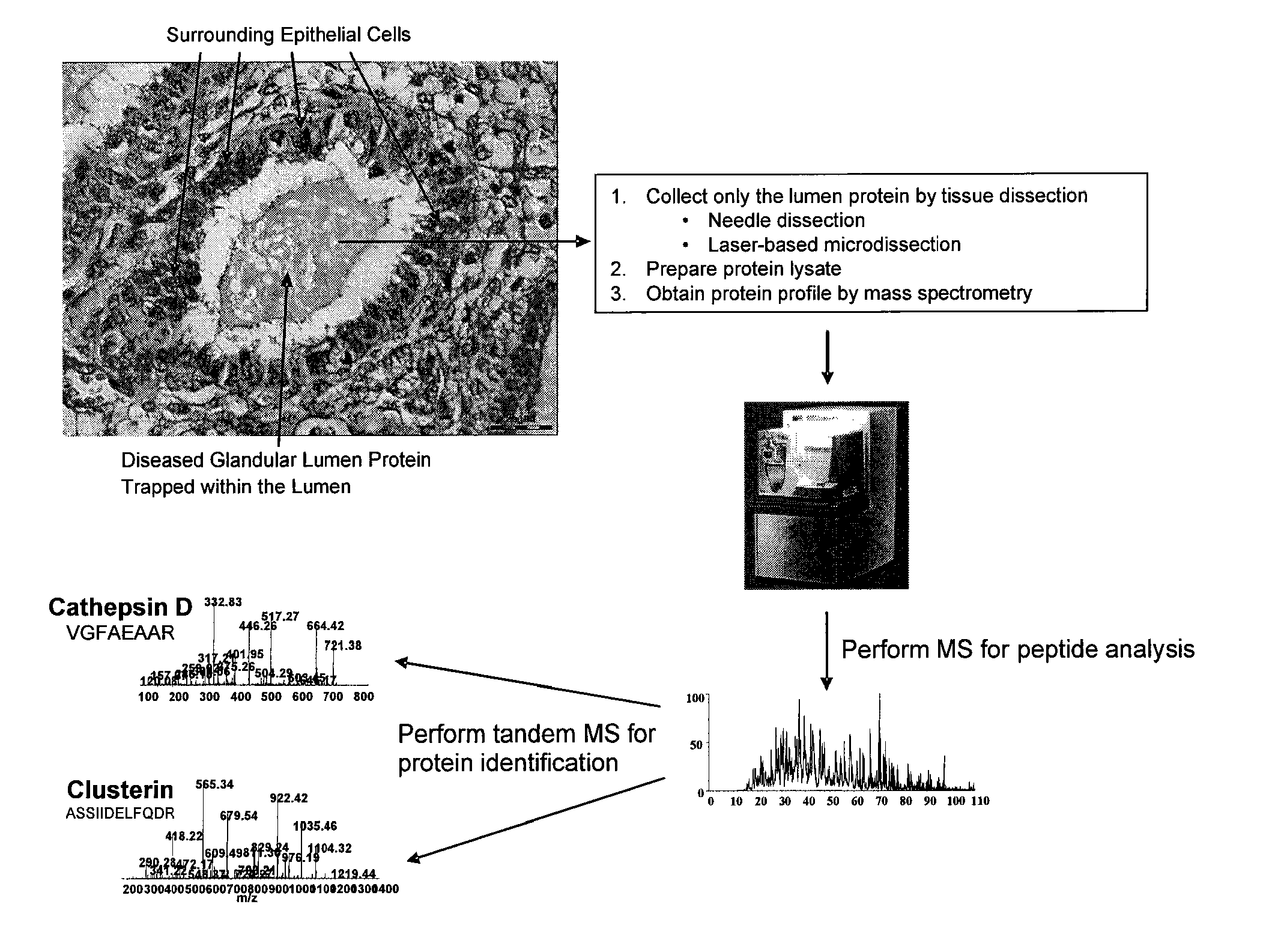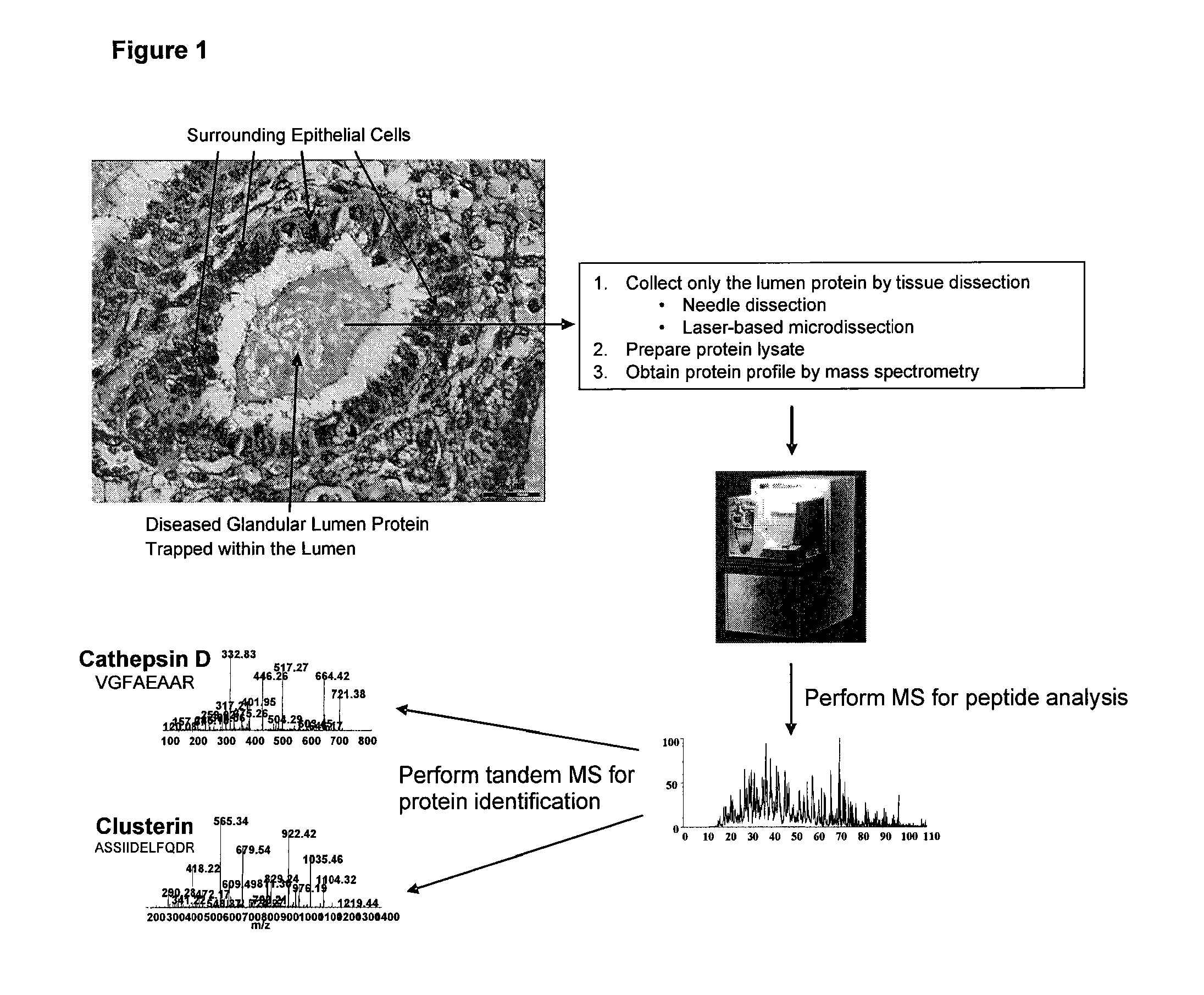Method of discovering and analyzing secreted biomarkers of disease from solid tissue
a biomarker and solid tissue technology, applied in the field of biological sample composition and method, can solve the problems of few known biomarkers that are detected in tissue, can not be detected and assayed, and can affect the tissue and cellular structure of the biological sample, and affect the protein cross-linking. , the effect of disrupting the tissue and cellular structur
- Summary
- Abstract
- Description
- Claims
- Application Information
AI Technical Summary
Benefits of technology
Problems solved by technology
Method used
Image
Examples
example 1
[0033]Table 1 is a list of proteins found commonly expressed both in uterine fluid as discovered from a literature survey and in soluble protein lysate from the glandular lumen shown in FIG. 1. Of note is that all of the proteins previously shown to be secreted by endometrial cells through a survey of the published literature between 1986 and 2003 are also identified in the protein profile of the endometrial glandular lumen.
example 2
[0034]Table 2 shows results from an analysis that determined what types of proteins are present in the glandular lumen protein profile and compares that to the types of proteins from a protein profile determined by mass spectrometry of protein from epithelial cells. Note that the highest percentage of protein in the glandular lumen sample represents proteins that are extracellular associated and membrane bound, whereas a smaller percentage of the total protein is of intracellular origin. The highest percentage of protein in the epithelial cell sample is of intracellular origin. These results indicate that the lumen does in fact contain predominantly secreted extracellular protein and that this invention is advantageous for specifically identifying secreted protein by analysis of protein present within organ and glandular lumens.
example 3
[0035]FIG. 4 shows the complete list of proteins identified by mass spectrometry analysis of a soluble protein lysate derived from the organ / glandular lumen from a single histopathologically processed solid tumor tissue sample of endometrial origin shown in FIG. 1.
TABLE 1Galectin-3 binding protein precursor (Lectin galactoside-binding soluble 3 binding protein)Gelsolin precursor (Actin-depolymerizing factor)(ADF)(Brevin)(AGEL)Glycodelin precursor (GD)(Pregnancy-associated endometrial alpha-2 globulin)Heat shock cognate 71 kDa protein (Heat shock 70 kDa protein 8)Heat shock protein HSP 90-beta (HSP 84)(HSP 90)Heat shock-related 70 kDa protein 2 (Heat shock 70 kDa protein 2)Insulin-like growth factor binding protein 7 precursor (IGFBP-7)(IBP-7)Lipocalin-1 precursor (Von Ebner gland protein)(VEG protein) (Tear prealbumin)Serotransferrin precursor (Transferrin)(Siderophilin)(Beta-1-metal binding globulin)
TABLE 2Cancer CellLumen ProteinExtracellular Proteins9.31%37.88%Intracellular Prote...
PUM
| Property | Measurement | Unit |
|---|---|---|
| mass spectrometry | aaaaa | aaaaa |
| freezing | aaaaa | aaaaa |
| temperature | aaaaa | aaaaa |
Abstract
Description
Claims
Application Information
 Login to View More
Login to View More - R&D
- Intellectual Property
- Life Sciences
- Materials
- Tech Scout
- Unparalleled Data Quality
- Higher Quality Content
- 60% Fewer Hallucinations
Browse by: Latest US Patents, China's latest patents, Technical Efficacy Thesaurus, Application Domain, Technology Topic, Popular Technical Reports.
© 2025 PatSnap. All rights reserved.Legal|Privacy policy|Modern Slavery Act Transparency Statement|Sitemap|About US| Contact US: help@patsnap.com


